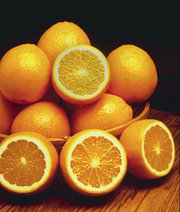Orange (fruit)
|
|
- For other meanings of "orange", see orange (disambiguation). For the etymology of the word "orange", see orange (word).
| Orange | ||||||||||||||||
|---|---|---|---|---|---|---|---|---|---|---|---|---|---|---|---|---|
| Missing image OrangeBloss_wb.jpg Orange flowers and oranges on tree | ||||||||||||||||
| Scientific classification | ||||||||||||||||
|
Navel_orange_sectioned.jpg
Blood_oranges.jpg
Orange refers to a citrus tree (Citrus × sinensis) and the fruits of this tree. It is a hybrid of ancient cultivated origin, possibly between pummelo (Citrus maxima) and tangerine (Citrus reticulata). It is a small tree, growing to about 10 m tall, with thorny shoots and evergreen leaves 4-10 cm long. The fruit originated in southeast Asia, in either India, Vietnam or southern China. The original fruit is rather bitter compared to modern cultivars, and is referred to as the sour orange (or alternately, bitter, bigarade or Seville orange). The sour taste is in fact attributed to the slight acidity of the orange's juice.
| Contents |
Cultivation and uses
Orange cultivation is a major business and an important part of the economies of the US states of Florida and California, many Mediterranean countries, Romania, South Africa, China, and the Riverina district around the Murray River in Australia.
Oranges are widely grown in warm climates worldwide, and the flavors of orange vary from sweet to sour. The fruit is commonly peeled and eaten fresh, or squeezed for its juice. It has a thick bitter rind that is usually discarded, but can be processed into animal feed by removing water using pressure and heat. It is also used in certain recipes as flavoring or a garnish. The outer-most layer of the rind is grated or thinly veneered with a tool called a zester, to produce orange zest which is popular in cooking because it has a similar flavor to the fleshy inner part of the orange. The white part of the rind, called the pith, is almost always discarded. Oranges also can be used to create citrus oil, which is used in aromatherapy to uplift and relieve stress.
Other products made from oranges include:
- Orange juice is one of the commodities traded on the New York commodities market. Brazil is the largest producer of orange juice in the world, followed by Florida, USA.
- Orange oil, produced by pressing the peel, is used in surface conditioning of wooden furniture, and along with other citrus oils in grease removal and as a hand-cleansing agent. Orange spray, extracted from orange peels and sold commercially, is an extremely efficient cleaning agent which is environmentally friendly and non-toxic. It also smells much more pleasant than other cleaning agents.
- The orange blossom, which is the state flower of Florida, is traditionally associated with good fortune, and was popular in bridal bouquets and headwreaths for weddings for some time. The petals of orange blossom can also be made into a delicately citrus-scented version of rosewater.
- Orange blossom honey, or actually citrus honey, is produced by putting beehives in the citrus groves during bloom, which also pollinates seeded citrus varieties. Orange blossom honey is highly prized, and tastes much like orange.
Cultivars
All citrus trees are of the single genus Citrus, and remain largely interbreedable; that is, there is only one "superspecies" which includes lemons, limes and oranges. Nevertheless, names have been given to the various members of the citrus family, oranges often being referred to as Citrus sinensis and Citrus aurantium. All members of the genus Citrus are considered berries because they have many seeds, are fleshy, soft and derive from a single ovary.
A number of cultivars are now cultivated around the world. The sweet orange (Citrus x aurantium) was first grown in Spain, and has become the most popular variety. The sweet orange will grow to different sizes and colors according to local conditions, most commonly with ten carpels, or slices, inside.
A single mutation in 1820 in an orchard of sweet oranges planted at a monastery in Brazil led to the navel orange, also known as the Washington, Riverside or Bahia navel. A single cutting of the original was then transplanted to Riverside, California in 1870, creating a new market worldwide. The mutation causes a 'twin' fruit, with a smaller orange embedded in the outer fruit opposite the stem. From the outside, the smaller, undeveloped twin leaves a formation at the top of the fruit, looking similar to the human navel. Navel oranges are almost always seedless, and tend to be larger than the sweet orange. They are produced without pollination, through parthenocarpy.
The Valencia or Murcia orange is one of the sweet oranges used for juice extraction. It is a late-season fruit, and therefore a popular variety when the navel oranges are out of season.
The blood orange has streaks of red in the fruit, and the juice is often reddish. The mandarin orange is similar, but smaller and sweeter, and the scarlet navel is a variety with the same diploid mutation as the navel orange.
Bitter oranges are used in marmalade and as an ingredient in liqueurs such as triple sec and curaçao.
Etymology
Comes from middle english norange, a norange transformed into an orange. Norange can be likened to Spanish naranja, meaning orange.
See also
External links
- Nutrition data for raw oranges (http://www.nutritiondata.com/facts-001-02s01im.html), from nutritiondata.combe:Апельсін
cy:Oren (ffrwyth) da:Appelsin de:Orange (Frucht) es:naranja (fruto) fr:Orange (fruit) he:תפוז nl:Sinaasappel ja:オレンジ pl:Pomarańcza simple:Orange fi:Appelsiini sv:Apelsin zh:柑橘


